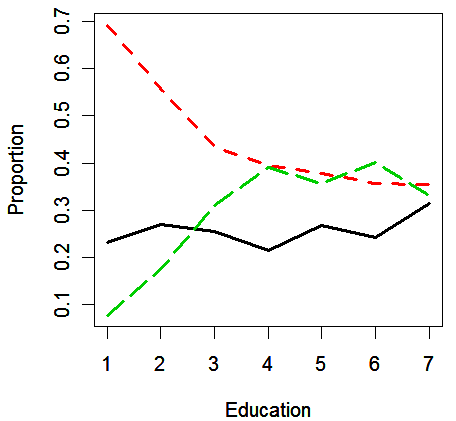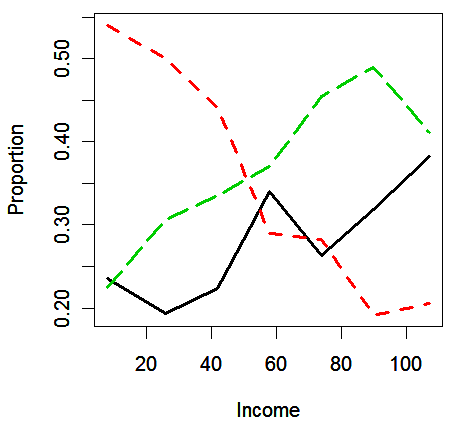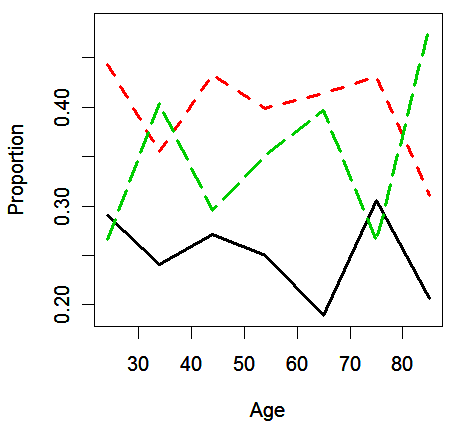
¡@
Consider a data from the 1996 American National Election Study. Let us first read the data into R and take a look:
> nes96 <- read.table("nes96.txt")
> nes96
popul TVnews selfLR ClinLR DoleLR PID age educ income vote
1 0 7 extCon extLib Con strRep 36 HS $3Kminus Dole
2 190 1 sliLib sliLib sliCon weakDem 20 Coll $3Kminus Clinton
3 31 7 Lib Lib Con weakDem 24 BAdeg $3Kminus Clinton
...deleted...
944 18 7 Mod Lib Con indind 61 MAdeg $105Kplus Dole
¡@
For simplicity, we consider only the variables age, educ (education level), and income (income group of the respondents) as the predictors. Our response will be PID (party identification) of the respondents. The original PID involved 7 categories; we will collapse this to three: Democrat, Independent, or Republican, again for simplicity of the presentation. The category Democrat, after collapse, will be regarded as the baseline category.
>
sPID <- nes96$PID
>
levels(sPID)
[1] "indDem" "indind" "indRep" "strDem" "strRep" "weakDem" "weakRep"
>
levels(sPID) <-
c("Independent", "Independent", "Independent", "Democrat", "Republican",
"Democrat", "Republican")
>
levels(sPID)
[1] "Independent" "Democrat" "Republican"
>
sPID <- relevel(sPID, ref="Democrat")
>
summary(sPID)
Democrat Independent Republican
380 239 325
¡@
The income variable in the original data was an ordered factor with income ranges. We would like to convert this to a numeric variable by taking the midpoint of each range:
> levels(nes96$income)
[1] "$105Kplus" "$10K-$11K" "$11K-$12K" "$12K-$13K" "$13K-$14K" "$14K-$15K"
[7] "$15K-$17K" "$17K-$20K" "$20K-$22K" "$22K-$25K" "$25K-$30K" "$30K-$35K"
[13] "$35K-$40K" "$3K-$5K" "$3Kminus" "$40K-$45K" "$45K-$50K" "$50K-$60K"
[19] "$5K-$7K" "$60K-$75K" "$75K-$90K" "$7K-$9K" "$90K-$105K" "$9K-$10K"
>
inca <-
c(115, 10.5, 11.5, 12.5, 13.5, 14.5, 16, 18.5,
21, 23.5, 27.5, 32.5, 37.5, 4, 1.5, 42.5, 47.5, 55,
6, 67.5, 82.5, 8, 97.5, 9.5)
>
nincome <- inca[unclass(nes96$income)]
>
summary(nincome)
Min. 1st Qu. Median Mean 3rd Qu. Max.
1.50 23.50 37.50 46.58 67.50 115.00
¡@
The educ variable is also an ordered factor. The default of R sorts the levels in alphabetical order so that we must re-arrange them according to their natural order:
> levels(nes96$educ)
[1] "BAdeg" "CCdeg" "Coll" "HS" "HSdrop" "MAdeg" "MS"
> nes96$educ <- factor(nes96$educ, levels=c("MS", "HSdrop", "HS", "Coll", "CCdeg", "BAdeg", "MAdeg"))
> levels(nes96$educ)
[1] "MS" "HSdrop" "HS" "Coll" "CCdeg" "BAdeg" "MAdeg"
MS HSdrop HS Coll CCdeg BAdeg MAdeg
13 52 248 187 90 227 127
¡@
Let us start with a graphical look at the relationship between the predictors and the response. The response is at the individual level and so we need to group the data just to get a sense of how the party identification is associated with the predictors:
> matplot(prop.table(table(nes96$educ,sPID),1), type="l", xlab="Education", ylab="Proportion", lty=c(1,2,5), lwd=2)

We see that
the proportion of Democrat (red line) falls with educational status, reaching a plateau for the college educated (level 4 or above)
the proportion of Republican (black line) rising with educational level and reaching a similar plateau
We cut the income variable into seven levels and use the approximate midpoints of the ranges to label the seven groups:
>
cutinc <- cut(nincome,7)
>
il <- c(8,26,42,58,74,90,107)
>
matplot(il,prop.table(table(cutinc,sPID),1), lty=c(1,2,5), type="l", ylab="Proportion", xlab="Income",
lwd=2)

We see that as the income increases,
the proportion of Republican (black line) and Independent (green line) increases
the proportion of Democrat (red line) decreases
The age
variable is also cut into seven levels and use the approximate midpoints of the
ranges to label the groups:
>
cutage <- cut(nes96$age,7)
>
al <- c(24,34,44,54,65,75,85)
>
matplot(al,prop.table(table(cutage,sPID),1), lty=c(1,2,5), type="l", ylab="Proportion", xlab="Age",
lwd=2)

We see that the relationship between party identification and age is not clear.
¡@
Notice that this is cross-sectional rather than longitudinal data
so, we cannot say anything about what might happen to an individual with, for example, increasing income
we can only expect to make conclusions about the relative probability of party affiliations for different individuals with different incomes
¡@
We might ask whether the trend we saw in the plots are statistically significant. We will need to model the data to answer this question.
¡@
¡@
Multinomial Logit Model.
We fit a multinomial logit model using Democrat as the baseline category. The multinom in the nnet package can do the job:
>
library(nnet)
>
mmod <- multinom(sPID ~ age + educ + nincome, nes96)
# weights: 30 (18 variable)
initial value 1037.090001
iter 10 value 987.979341
iter 20 value 984.299514
final value 984.166272
converged
The multinom program use the optimization method from the neural net trainer in nnet package to compute the maximum likelihood, but there is no deeper connection to neural networks.
¡@
We can select which variables to include the model based on the AIC criterion using a stepwise search method (c.f.: the difference-in-deviance approach for model selection given in previous lab):
> mmodi <- step(mmod)
Start: AIC= 2004.33
sPID ~ age + educ + nincome
trying - age
# weights: 27 (16 variable)
initial value 1037.090001
iter 10 value 989.159892
iter 20 value 985.851370
final value 985.812737
converged
trying - educ
# weights: 12 (6 variable)
initial value 1037.090001
final value 992.269484
converged
trying - nincome
# weights: 27 (16 variable)
initial value 1037.090001
iter 10 value 1008.225941
iter 20 value 1007.004978
final value 1006.955275
converged
Df AIC
- educ 6 1996.539
- age 16 2003.625
<none> 18 2004.333
- nincome 16 2045.911
# weights: 12 (6 variable)
initial value 1037.090001
final value 992.269484
converged
Step: AIC= 1996.54
sPID ~ age + nincome
trying - age
# weights: 9 (4 variable)
initial value 1037.090001
final value 992.712152
converged
trying - nincome
# weights: 9 (4 variable)
initial value 1037.090001
final value 1020.425203
converged
Df AIC
- age 4 1993.424
<none> 6 1996.539
- nincome 4 2048.850
# weights: 9 (4 variable)
initial value 1037.090001
final value 992.712152
converged
Step: AIC= 1993.42
sPID ~ nincome
trying - nincome
# weights: 6 (2 variable)
initial value 1037.090001
final value 1020.636052
converged
Df AIC
<none> 4 1993.424
- nincome 2 2045.272
We see that:
at the first stage, omitting educ (education) would be the best option to reduce the AIC criterion
at the next stage, age is removed resulting in a model with only income
exercise: check whether the model selection result is consistent with the information observed in the 3 plots given above, especially focus on the educ variable
¡@
We can also use the standard likelihood method to derive a deviance-based test to compare nested models. For example, we can fit a model without educ and then compare the deviances:
> mmode <- multinom(sPID ~ age + nincome, nes96)
# weights: 12 (6 variable)
initial value 1037.090001
final value 992.269484
converged
> deviance(mmode) - deviance(mmod)
[1] 16.20642
> mmod$edf-mmode$edf
[1] 12
> pchisq(16.20642, 12, lower=F)
[1] 0.1819635
We see that
educ (education) is not significant relative to the full model. This may seem somewhat surprising given the plot
however, the large differences between the proportions of Democrat and Republican occur for groups with low education, which represent only a small number of people:
> (13+52)/sum(summary(nes96$educ))
[1] 0.06885593
¡@
Based on the selected model under the AIC criterion, we can obtain predicted values for specified values of income. For example, suppose we pick the midpoints of the income groups we selected for the earlier plot:
> cbind(il, predict(mmodi,data.frame(nincome=il),type="probs"))
il Democrat Independent Republican
1 8 0.5566253 0.1955183 0.2478565
2 26 0.4804946 0.2254595 0.2940459
3 42 0.4134268 0.2509351 0.3356381
4 58 0.3493884 0.2743178 0.3762939
5 74 0.2903271 0.2948600 0.4148129
6 90 0.2375755 0.3121136 0.4503109
7 107 0.1891684 0.3266848 0.4841468
We see that:
the sum of proportions in same row must equal one
the probability of being Republican or Independent increases with income (Note: do not give a longitudinal-type conclusion)
the probability of being Democrat decreases with income
the default form of R just gives the most probably category:
> predict(mmodi,data.frame(nincome=il))
[1] Democrat Democrat Democrat Republican Republican Republican Republican
Levels: Democrat Independent Republican
¡@
We may also examine the coefficients to gain an understanding of the relationship between the predictors and the response:
> summary(mmodi, corr=F)
Call:
multinom(formula = sPID ~ nincome, data = nes96)
Coefficients:
(Intercept) nincome
Independent -1.174933 0.01608683
Republican -0.950359 0.01766457
Std. Errors:
(Intercept) nincome
Independent 0.1536103 0.002849738
Republican 0.1416859 0.002652532
Residual Deviance: 1985.424
AIC: 1993.424
We see that:
the Democrat category is the baseline category so that we do not find its coefficient in the output
the intercept terms model the probabilities of the party identification for an income of zero. We can see the relationship from this calculation:
>
cc <- c(0, -1.174933, -0.950359)
>
exp(cc)/sum(exp(cc))
[1] 0.5898167 0.1821588 0.2280245
The values are the same as:
> predict(mmodi,data.frame(nincome=0),type="probs")
Democrat Independent Republican
0.5898168 0.1821588 0.2280244
the slope terms represent the log-odds of moving from the baseline category of Democrat to Independent and Republican, respectively, for a unit change of $1000 in in come. We can see more explicitly what this means by predicting probabilities for income $1000 apart and then computing the log-odds:
> (pp <- predict(mmodi,data.frame(nincome=c(0,1)),type="probs"))
Democrat Independent Republican
1 0.5898168 0.1821588 0.2280244
2 0.5857064 0.1838228 0.2304708
> log(pp[1,1]*pp[2,2]/(pp[1,2]*pp[2,1]))
[1] 0.01608683
> log(pp[1,1]*pp[2,3]/(pp[1,3]*pp[2,1]))
[1] 0.01766457
log-odds can be difficult to interpret particularly with many predictors and interactions. Sometimes, computing predicted probabilities for a selected range of predictors can provide better intuition
¡@
¡@
Multinomial Log-Linear Model.
It is possible to fit a multinomial logit model using a Poisson GLM. We can
declare a factor that has a level for each category of the multinomial response, called response factor;
declare a factor that has a level for each covariate class in the data, called case factor;
and then, treat the individual components of the multinomial response as Poisson responses.
We can regard it as a 2-way table with case and response factors as row and column factors, respectively. We set up these variables, also illustrating what happens with the first three multinomial observations:
> sPID[1:3]
[1] Republican Democrat Democrat
Levels: Democrat Independent Republican
>
cm <- diag(3)[unclass(sPID),]
>
cm[1:3,]
[,1] [,2] [,3]
[1,] 0 0 1
[2,] 1 0 0
[3,] 1 0 0
>
y <- as.numeric(t(cm))
> y[1:9]
[1] 0 0 1 1 0 0 1 0 0
> length(y)
[1] 2832
The case factor is:
>
case.factor <- gl(944,3)
>
case.factor[1:9]
[1] 1 1 1 2 2 2 3 3 3
944 Levels: 1 2 3 4 5 6 7 8 9 10 11 12 13 14 15 16 17 18 19 20 21 22 23 24 25 26 ... 944
> length(case.factor)
[1] 2832
The response factor is:
>
res.factor <- gl(3,1,3*944,labels=c("D","I","R"))
>
res.factor <- relevel(res.factor, ref="D")
> res.factor[1:9]
[1] D I R D I R D I R
Levels: D I R
> length(res.factor)
[1] 2832
We also need to replicate the predictor income:
>
rnincome <- rep(nincome, each=3)
Now, examine the form of the reorganized data:
> data.frame(y, case.factor, res.factor, rnincome)[c(1:9),]
y case.factor res.factor rnincome
1 0 1 D 1.5
2 0 1 I 1.5
3 1 1 R 1.5
4 1 2 D 1.5
5 0 2 I 1.5
6 0 2 R 1.5
7 1 3 D 1.5
8 0 3 I 1.5
9 0 3 R 1.5
Notice that the income variable can be regarded as an effect of the case factor because for the (Poisson) observations with same values of case factor, their income values are identical.
¡@
As with the contingency table models, the null model has only main effects of row and column factors:
>
nullmod <- glm(y ~ case.factor + res.factor, family=poisson)
> summary(nulmod)
Call:
glm(formula = y ~ case.factor + res.factor, family = poisson)
Deviance Residuals:
Min 1Q Median 3Q Max
-0.8973 -0.8298 -0.7116 0.7906 1.1197
Coefficients:
Estimate Std. Error z value Pr(>|z|)
(Intercept) -9.100e-01 1.001e+00 -0.909 0.3632
case.factor2 7.716e-13 1.414e+00 5.46e-13 1.0000
case.factor3 7.714e-13 1.414e+00 5.45e-13 1.0000
...deleted...
case.factor944 1.118e-12 1.414e+00 7.91e-13 1.0000
res.factorI -4.637e-01 8.256e-02 -5.617 1.95e-08 ***
res.factorR -1.563e-01 7.555e-02 -2.069 0.0385 *
---
Signif. codes: 0 '***' 0.001 '**' 0.01 '*' 0.05 '.' 0.1 ' ' 1
(Dispersion parameter for poisson family taken to be 1)
Null deviance: 2074.2 on 2831 degrees of freedom
Residual deviance: 2041.3 on 1886 degrees of freedom
AIC: 5821.3
Number of Fisher Scoring iterations: 6
We see that:
there are 943 effects for the case factor because it has 944 levels, each for a covariate class
the 943 effects represent the differences between row marginal totals, which is not meaningful in the case
the model corresponds to a multinomial logit model without any predictors
the 2 effects of the response factor represent the difference between the 3 party affiliation categories
the fitted model has a large residual deviance of 2041.3 on 1886 degrees of freedom, which suggests that the probabilities of the three categories are not constant over the predictors
¡@
The effect of income is modeled with an interaction with party affiliation:
> glmod <- glm(y ~ case.factor + res.factor + res.factor:rnincome, family=poisson)
> summary(glmod)
Call:
glm(formula = y ~ case.factor + res.factor + res.factor:rnincome, family = poisson)
Deviance Residuals:
Min 1Q Median 3Q Max
-1.0804 -0.8050 -0.6985 0.6998 1.3756
Coefficients: (1 not defined because of singularities)
Estimate Std. Error z value Pr(>|z|)
(Intercept) -5.120e-01 1.001e+00 -0.511 0.609
case.factor2 -1.737e-10 1.414e+00 -1.23e-10 1.000
...deleted...
case.factor944 7.664e-01 1.423e+00 0.539 0.590
res.factorI -1.175e+00 1.536e-01 -7.649 2.03e-14 ***
res.factorR -9.504e-01 1.417e-01 -6.708 1.98e-11 ***
res.factorD:rnincome -1.766e-02 2.653e-03 -6.660 2.75e-11 ***
res.factorI:rnincome -1.578e-03 2.644e-03 -0.597 0.551
res.factorR:rnincome NA NA NA NA
---
Signif. codes: 0 '***' 0.001 '**' 0.01 '*' 0.05 '.' 0.1 ' ' 1
(Dispersion parameter for poisson family taken to be 1)
Null deviance: 2074.2 on 2831 degrees of freedom
Residual deviance: 1985.4 on 1884 degrees of freedom
AIC: 5769.4
Number of Fisher Scoring iterations: 6
We see that:
the deviance of the model, 1985.4, is the same as the multinomial logit model with income predictor given above
because only two interaction parameters are identifiable, the last one res.factorR:rnincome, being inestimable, is not estimated.
the parameterization of the Poisson model is slightly different from the multinomial logit model. The Poisson model makes Republican as the reference level rather than Democrat. We can change it back by:
>
res.factorI_rnincome <- model.matrix(glmod)[,948]
>
res.factorR_rnincome <- model.matrix(glmod)[,949]
>
glmodrD <- glm(y ~ case.factor + res.factor + res.factorI_rnincome +
res.factorR_rnincome, family=poisson)
> summary(glmodrD)
Call:
glm(formula = y ~ case.factor + res.factor + res.factorI_rnincome +
res.factorR_rnincome, family = poisson)
Deviance Residuals:
Min 1Q Median 3Q Max
-1.0804 -0.8050 -0.6985 0.6998 1.3756
Coefficients:
Estimate Std. Error z value Pr(>|z|)
(Intercept) -5.385e-01 1.001e+00 -0.538 0.591
case.factor2 -1.737e-10 1.414e+00 -1.23e-10 1.000
...deleted...
case.factor944 -1.239e+00 1.427e+00 -0.868 0.385
res.factorI -1.175e+00 1.536e-01 -7.649 2.03e-14 ***
res.factorR -9.504e-01 1.417e-01 -6.708 1.98e-11 ***
res.factorI_rnincome 1.609e-02 2.850e-03 5.645 1.65e-08 ***
res.factorR_rnincome 1.766e-02 2.653e-03 6.660 2.75e-11 ***
---
Signif. codes: 0 '***' 0.001 '**' 0.01 '*' 0.05 '.' 0.1 ' ' 1
(Dispersion parameter for poisson family taken to be 1)
Null deviance: 2074.2 on 2831 degrees of freedom
Residual deviance: 1985.4 on 1884 degrees of freedom
AIC: 5769.4
Number of Fisher Scoring iterations: 6
We find that:
the Poisson model generates the same coefficients as the multinomial logit model above
the intercept terms in the multinomial logit model become the main effects of the response factor and the slopes terms become the interactions
we can get the same results of the multinomial logit model using the Poisson model. In other words, the multinomial logit model can be viewed as a GLM-type model, which allows us to apply all the common methodology developed for GLM
¡@
¡@
¡@
¡@